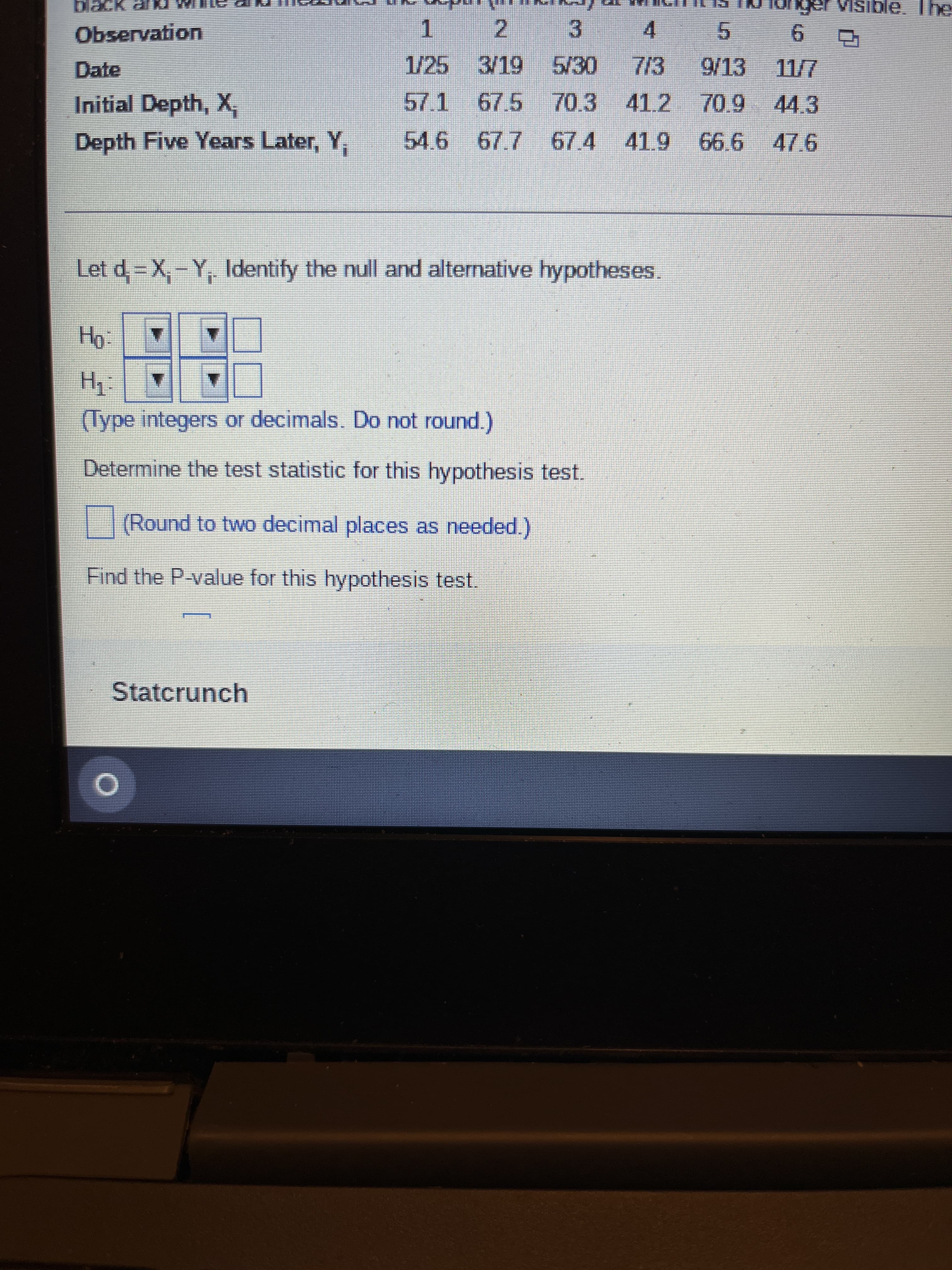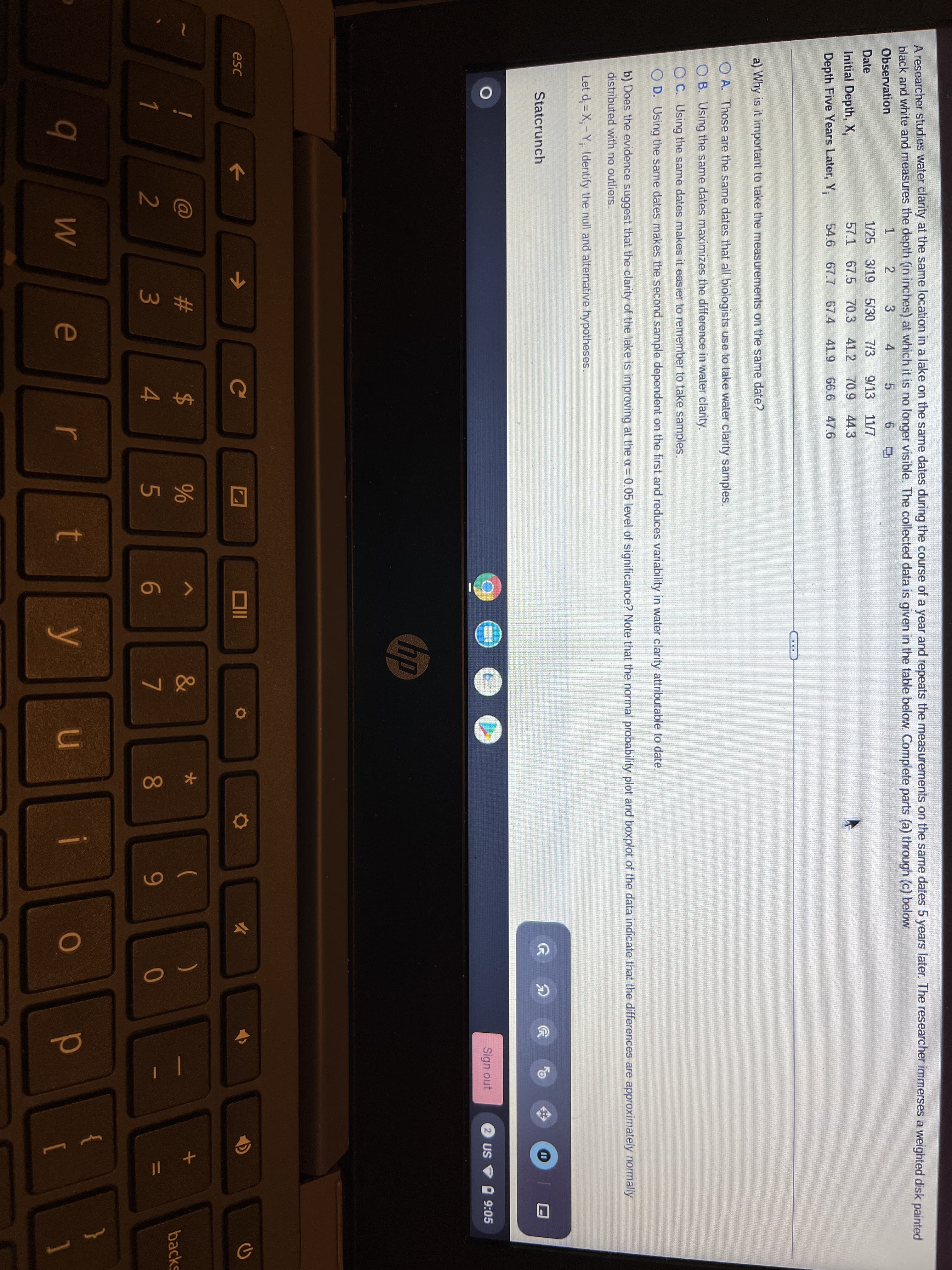Visible, The Observation 1 2 5. 3. 4. 6. Date 1/25 3/19 5/30 7/3 Initial Depth, X, 57.1 67.5 70.3 41.2 70,9 44.3 Depth Five Years Later, Y, 54.6 67.7 67.4 41.9 66.6 476 Let d= X,- Y, Identify the null and alternative hypotheses. (Type integers or decimals. Do not round.) Determine the test statistic for this hypothesis test. (Round to two decimal places as needed.) Find the P-value for this hypothesis test. Statcrunch A researcher studies water clarity at the same location in a lake on the same dates during the course of a year and repeats the measurements on the same dates 5 years later. The researcher immerses a weighted disk painted black and white and measures the depth (in inches) at which it is no longer visible. The collected data is given in the table below. Complete parts (a) through (c) below Observation 3 4 Date 1/25 3/19 5/30 7/3 9/13 11/7 Initial Depth, X, 57.1 67.5 70.3 41.2 70.9 44.3 Depth Five Years Later, Y, 54.6 67.7 67.4 41.9 66.6 47.6 a) Why is it important to take the measurements on the same date? O A. Those are the same dates that all biologists use to take water clarity samples. O B. Using the same dates maximizes the difference in water clarity. O C. Using the same dates makes it easier to remember to take samples. O D. Using the same dates makes the second sample dependent on the first and reduces variability in water clarity attributable to date. b) Does the evidence suggest that the clarity of the lake is improving at the a= 0.05 level of significance? Note that the normal probability plot and boxplot of the data indicate that the differences are approximately normally distributed with no outliers. Let d = X, -Y, Identify the null and alternative hypotheses. Statcrunch Sign out 2 US O 9:05 hp esc -> Ce C@ %23 2$ & ( backs 5 6 7 08. 9- %3D 1 3 { } e r t y [
Visible, The Observation 1 2 5. 3. 4. 6. Date 1/25 3/19 5/30 7/3 Initial Depth, X, 57.1 67.5 70.3 41.2 70,9 44.3 Depth Five Years Later, Y, 54.6 67.7 67.4 41.9 66.6 476 Let d= X,- Y, Identify the null and alternative hypotheses. (Type integers or decimals. Do not round.) Determine the test statistic for this hypothesis test. (Round to two decimal places as needed.) Find the P-value for this hypothesis test. Statcrunch A researcher studies water clarity at the same location in a lake on the same dates during the course of a year and repeats the measurements on the same dates 5 years later. The researcher immerses a weighted disk painted black and white and measures the depth (in inches) at which it is no longer visible. The collected data is given in the table below. Complete parts (a) through (c) below Observation 3 4 Date 1/25 3/19 5/30 7/3 9/13 11/7 Initial Depth, X, 57.1 67.5 70.3 41.2 70.9 44.3 Depth Five Years Later, Y, 54.6 67.7 67.4 41.9 66.6 47.6 a) Why is it important to take the measurements on the same date? O A. Those are the same dates that all biologists use to take water clarity samples. O B. Using the same dates maximizes the difference in water clarity. O C. Using the same dates makes it easier to remember to take samples. O D. Using the same dates makes the second sample dependent on the first and reduces variability in water clarity attributable to date. b) Does the evidence suggest that the clarity of the lake is improving at the a= 0.05 level of significance? Note that the normal probability plot and boxplot of the data indicate that the differences are approximately normally distributed with no outliers. Let d = X, -Y, Identify the null and alternative hypotheses. Statcrunch Sign out 2 US O 9:05 hp esc -> Ce C@ %23 2$ & ( backs 5 6 7 08. 9- %3D 1 3 { } e r t y [
Algebra & Trigonometry with Analytic Geometry
13th Edition
ISBN:9781133382119
Author:Swokowski
Publisher:Swokowski
Chapter3: Functions And Graphs
Section3.3: Lines
Problem 76E
Related questions
Question

Transcribed Image Text:Visible, The
Observation
1 2
5.
3.
4.
6.
Date
1/25 3/19 5/30
7/3
Initial Depth, X,
57.1 67.5 70.3 41.2 70,9 44.3
Depth Five Years Later, Y,
54.6 67.7 67.4 41.9 66.6 476
Let d= X,- Y, Identify the null and alternative hypotheses.
(Type integers or decimals. Do not round.)
Determine the test statistic for this hypothesis test.
(Round to two decimal places as needed.)
Find the P-value for this hypothesis test.
Statcrunch

Transcribed Image Text:A researcher studies water clarity at the same location in a lake on the same dates during the course of a year and repeats the measurements on the same dates 5 years later. The researcher immerses a weighted disk painted
black and white and measures the depth (in inches) at which it is no longer visible. The collected data is given in the table below. Complete parts (a) through (c) below
Observation
3
4
Date
1/25
3/19
5/30
7/3
9/13
11/7
Initial Depth, X,
57.1
67.5
70.3
41.2 70.9
44.3
Depth Five Years Later, Y,
54.6 67.7
67.4
41.9
66.6 47.6
a) Why is it important to take the measurements on the same date?
O A. Those are the same dates that all biologists use to take water clarity samples.
O B. Using the same dates maximizes the difference in water clarity.
O C. Using the same dates makes it easier to remember to take samples.
O D. Using the same dates makes the second sample dependent on the first and reduces variability in water clarity attributable to date.
b) Does the evidence suggest that the clarity of the lake is improving at the a= 0.05 level of significance? Note that the normal probability plot and boxplot of the data indicate that the differences are approximately normally
distributed with no outliers.
Let d = X, -Y, Identify the null and alternative hypotheses.
Statcrunch
Sign out
2 US
O 9:05
hp
esc
->
Ce
C@
%23
2$
&
(
backs
5
6
7
08.
9-
%3D
1
3
{
}
e
r
t
y
[
Expert Solution
This question has been solved!
Explore an expertly crafted, step-by-step solution for a thorough understanding of key concepts.
Step by step
Solved in 3 steps with 2 images

Recommended textbooks for you

Algebra & Trigonometry with Analytic Geometry
Algebra
ISBN:
9781133382119
Author:
Swokowski
Publisher:
Cengage

Linear Algebra: A Modern Introduction
Algebra
ISBN:
9781285463247
Author:
David Poole
Publisher:
Cengage Learning

Algebra & Trigonometry with Analytic Geometry
Algebra
ISBN:
9781133382119
Author:
Swokowski
Publisher:
Cengage

Linear Algebra: A Modern Introduction
Algebra
ISBN:
9781285463247
Author:
David Poole
Publisher:
Cengage Learning